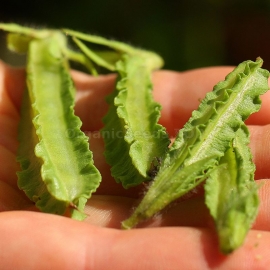
«Yellow Cream» - Organic Alpine Strawberry Seeds
1.14 €
Yellow Cream Alpine strawberry seeds are a bit easier to start than some others. Start the seeds indoors as early as December, and transplant outdoors one week after your last average frost date. That’s around the first or second week in April.
-
Organic Alpine Strawberry «Yellow Cream»
Yellow Cream Alpine strawberry seeds are a bit easier to start than some others. Start the seeds indoors as early as December, and transplant outdoors one week after your last average frost date.
That’s around the first or second week in April. With this kind of head start, the plants will produce fruit in the first year. Yellow Cream has the lovely oblong shape of alpine types, but with yellow skin and flesh and incredible sweetness. The plants are low growing, but very productive, even in containers. The seeds can also be sown later in the year, but plan on harvesting berries from the second year of growth forward.
How to Grow
Alpine strawberries have a reputation of being hard to grow, but that isn’t necessarily true. They are quite easy to grow from seed, provided you start them at the right time of year and are diligent in your care. If you follow these simple steps, you could have a lovely ground-cover alpine strawberry plant in your own garden by next spring! The best conditions to grow alpine strawberries are slightly acidic, well-draining soil exposed to partial sun and regular precipitation.
- Step 1 – Choose your variety of alpine strawberry (depending on the climate you live in, do your research on which cultivar is best – Alexandria, Ruegen, White Soul, Yellow Wonder etc.)
- Step 2 – To germinate the seeds, place them on top of moist, acid-rich soil in a small planter. It is important to keep the soil moist at all times; even a few hours of complete dryness can stop the germination process.
- Step 3 – Once the seeds have germinated, place the planter in a bright window where it can receive ample sunlight. If germinating seeds outdoors, ensure that the seeds are blocked from wind, but not obstructed from sunlight.
- Step 4 – Keep the germinating seeds at a temperature between 65 and 75 degrees Fahrenheit for best results. Lower temperatures will slow the germination process.
- Step 5 – Once the plants begin to form, they can be moved out of the planter and into soil outside, but these strawberry plants are fickle, and will often not take unless the soil is ideally matched to their original growth conditions.
- Step 6 – Regularly water the plants in the middle months of growth, but ensure air movement so the dampness does not cause rot or other common diseases.
- Step 7 – After approximately 4 months, the plant should bear its first delicious fruit!
Products Viewed Before
Product code: 15304
1.14 €
An early variety, fruits are bright red 80-100 grams, have an elongated shape, with a sharp tip, reminiscent of cucumbers, the pulp is amazingly sweet, very juicy, rarely affected by diseases and does not wrinkle during transportation.
Product code: 12665
2.00 €
The Asparagus Pea is an annual plant with partially reclining shoots; it grows 20 to 30 centimetres in length. In the summer, the shoots produce gorgeous scarlet flowers that are navicular in shape.
Product code: 13862
1.14 €
Mid-season, productive variety, the beans are wide, flat, greenish-white in color, very tasty, intended for fresh consumption or culinary processing of dry seeds.
Product code: 2874
1.14 €
The Heart Nut tree is named for the shape of the nut - a flattened heart-shaped nut that easily splits into two halves, like two sides of a locket. Native to Japan, it is also known as Japanese Walnut, but it is well suited to our Northern climates.




